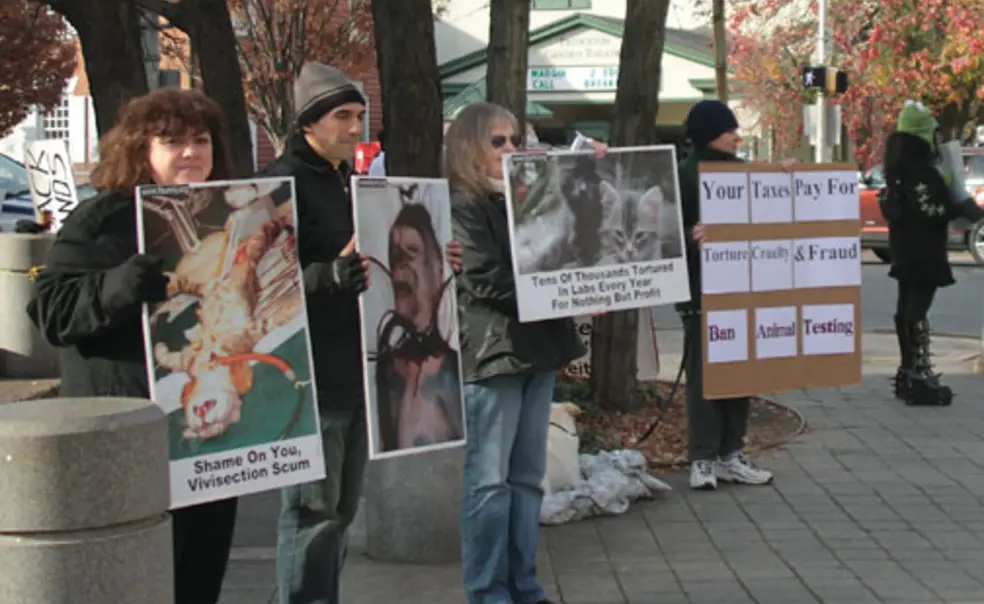Animal care under scrutiny by USDA, activist groups
The University’s treatment of laboratory animals has drawn attention from the federal government and from animal-rights activists.
In the last two years, Princeton’s animal labs have been cited for 21 instances of non-compliance with the federal Animal Welfare Act by the U.S. Department of Agriculture. Those findings prompted animal-rights groups to hold three protests on Nassau Street during the fall and create a TV commercial, broadcast locally, accusing the University of abusing animals.
While several of the government citations were for incomplete paperwork and other issues not directly related to animal care, such as having expired medications, the USDA also found that Princeton had deprived animals of water beyond the approved period and failed to provide adequate medical care to animals. The seven citations issued in 2011 came after inspections in February, April, and June. The USDA sent Princeton a warning notice in May for two violations — including not attending properly to a pregnant marmoset — which advised that penalties of up to $3,750 could be imposed if the violations were repeated.
University spokesman Martin A. Mbugua responded, “We take any and all allegations seriously and are committed to the care and welfare of animals.”
Veterinarian Laura Conour, who was hired last July to oversee animal research, said Princeton “has been looking very closely at these matters, and we expect to determine areas where we might enhance our procedures.” She supervises a staff of 16 people who feed, water, and clean animals in the University’s care.
The University has increased training for those who care for animals, hired additional compliance personnel, and improved its procedures for handling animals and monitoring their health, Mbugua said. In July it also established an Office of Research Integrity and Assurance that will oversee compliance with regulations regarding animals.
Princeton does not reveal specific information about the number of faculty members who use animals in their research or about their experiments “for security reasons,” Mbugua said. The University has “a small program” in which “mice, rats, and fish make up 99 percent of the animals used in research,” he said. Researchers also use guinea pigs, frogs, salamanders, and two types of monkeys, macaques and marmosets, according to Mbugua.
“Animal research at institutions like Princeton leads to breakthroughs that benefit not only people, but also the environment and even other animal species,” he said.
In September, the Physicians Committee for Responsible Medicine, which addresses controversies in medicine, released a study of animal welfare act violations at the eight Ivy institutions, based on an analysis of USDA violations for the last three years that gives more weight to severe and repeat violations than less-signifcant ones. Princeton tied with Yale for the second-worst record.
The same month a group called Stop Animal Exploitation Now! (SAEN) filed a complaint with the USDA that accused the University of “major violations of the Animal Welfare Act,” based on information the group said it received from someone who “is or was employed at Princeton” and was “directly involved with primates,” said SAEN executive director Michael Budkie. The group, which is based in Ohio, opposes all experimentation with animals. In a letter, released by SAEN, the whistleblower stated that he observed marmosets being scalded to death when they inadvertently were left in a cage being washed with boiling water, and neglect of marmosets that were ill.
USDA spokesman David Sacks said Dec. 5 that the allegations had been investigated and an inspector determined that “there were no violations of the Animal Welfare Act” relating to that complaint. The University is investigating the complaint, but spokeswoman Cass Cliatt ’96 noted that a Princeton hotline regarding compliance issues had received no information related to SAEN’s allegations.
The animal-rights group ran commercials in the Princeton area on five cable channels for two weeks in late November and early December that accused the University of torturing animals. Only one of the three images shown — of monkeys in cages and strapped in restraint chairs — came from a Princeton lab, according to Budkie. The commercial urged viewers to contact President Tilghman.
University spokesman Mbugua accused SAEN and other groups that have criticized the University of “distortions and sensationalist tactics intended to mislead the public.”
On a chilly Saturday in November, a dozen protesters occupied the corner of Nassau Street and Washington Road, holding signs reading “Shame on Princeton” and “Warning! Animal Abuse Inside.” The group, from the NY/NJ/PA Anti-Vivisection Alliance, said more protests are planned.













No responses yet